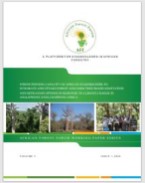The vulnerability of rural households to climate change in Africa is caused by exposure to climate variability and extreme weather events and by a combination of social, economic and environmental factors that interact with climate change. There is growing evidence that climate change is affecting forests resources in Africa. The effect on the forest resource is mainly as a result of vulnerable communities adapting to climate change through the use and in some cases over use of the forestry goods and services. Since the Kyoto Protocol and several COP Agreements, the role of forestry and trees in a landscape in general in addressing climate change through mitigation and adaptation has gathered pace. This was initially through the promotion of conservation of forests and woodlands as a means of reducing emissions especially carbon dioxide. However, there is increasing understanding that there is an intrinsic link between people and the forest landscape as forests go beyond safety net in addressing the livelihoods of communities in proximity as well as ecosystem services including climate change. The appreciation of forest-based interventions to address climate change adaptation and mitigation has gained attraction; and has been identified by the IPCC including trees in a multifunctional landscape. As a result, a number of donor funded development programme and projects were initiated in Africa response of climate change.

